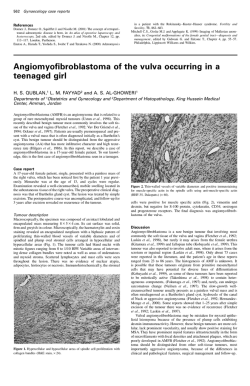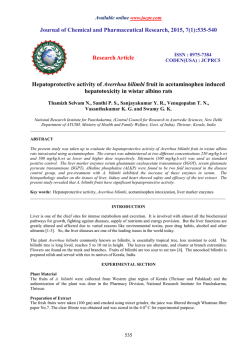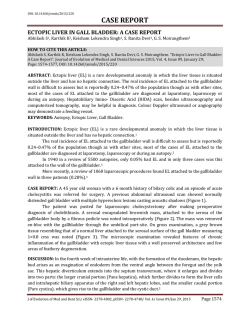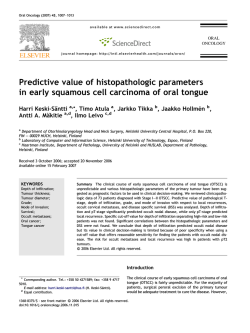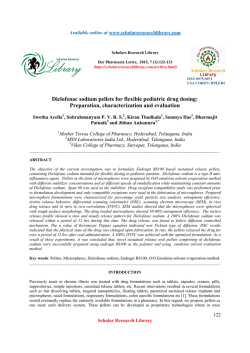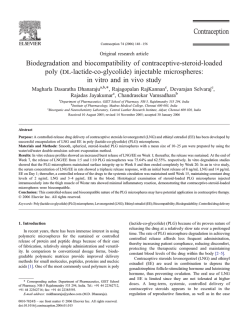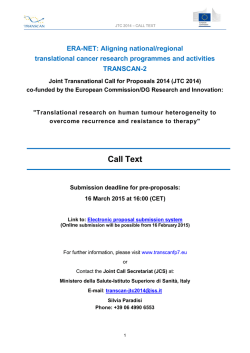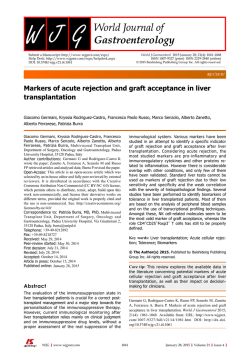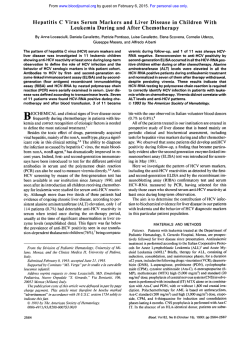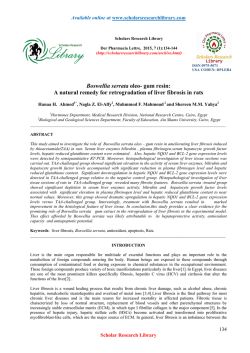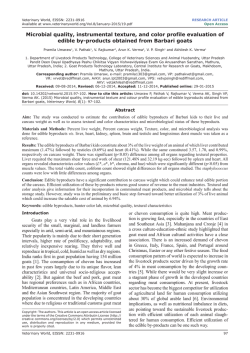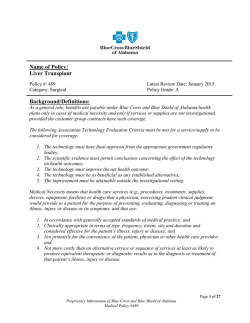
Targeting of liver tumour in rats by selective delivery
Chapter 6 Targeting of liver tumour in rats by selective delivery of holmium-166 loaded microspheres: a biodistribution study in press (European Journal of Nuclear Medicine) J.F.W. Nijsen1, D.W. Rook1, C.J.W.M. Brandt2, R. Meijer3, H.F.J. Dullens4, B.A. Zonnenberg1, J.M.H. de Klerk1, P.P. van Rijk1, W.E. Hennink5 and A.D. van het Schip1 1 Department of Nuclear Medicine, University Medical Center, Utrecht, The Netherlands Central Laboratory Animal Institute, University of Utrecht, Utrecht, The Netherlands 3 Department of Radiology, University Medical Center, Utrecht, The Netherlands 4 Department of Pathology, University Medical Center, Utrecht, The Netherlands 5 Department of Pharmaceutics, Utrecht Institute for Pharmaceutical Sciences, Utrecht University, Utrecht, The Netherlands 2 Chapter 6 Abstract Intra-arterial administration of beta-emitting particles that become trapped in the vascular bed of a tumour and remain there while delivering high doses, comprises an unique application in the treatment of both primary and metastatic liver tumours. Studies on selective internal radiation therapy of colorectal liver metastases using yttrium-90 glass microspheres have shown encouraging results. This study describes the biodistribution of 37 µm poly lactic acid microspheres loaded with radioactive holmium-166, after intra-arterial administration into the hepatic artery of rats with implanted liver tumours. Radioactivity measurements showed >95% retention of injected activity in the liver and its resident tumour. The average activity detected in other tissues was ≤0.1 %ID/g, with incidental exceptions in lungs and stomach. Very 166 little Ho activity was detected in kidneys (<0.1 %ID/g), thereby indicating the stability of the microspheres in vivo. Tumour targeting was very effective, with a mean tumour to liver ratio of 6.1±2.9 for rats with tumour (n=15), versus 0.7±0.5 for control rats (n=6; p<0.001). These ratios were not significantly affected by the use of adrenaline. Histological analysis showed that 5 times as many large (>10) and medium-sized (4-9) clusters of microspheres were present within tumour and peritumoural tissue, compared with normal liver. Single microspheres were equally dispersed throughout the tumour, as well as normal liver parenchyma. 96 Targeting of liver tumour by selective delivery 6.1 Introduction The liver is one of the most common sites of metastatic cancer in human beings, especially for metastases of colon and rectum carcinoma. Despite the advances in radiotherapy, chemotherapy and immunotherapy, surgical excision of localised disease is currently the only means of improving the survival in these patients [1]. However, surgical resection of liver metastases of colorectal carcinomas is possible in only 1030% of all cases [2,3]. There is therefore a great need for the development of an effective therapy. A promising alternative is intra-arterial radionuclide therapy. This depends upon the arterial blood supply to the liver metastases, and the subsequent infusion of the metastases with well-defined sized [4,5], radioactive microspheres. Tumours from 1-2 mm acquire their oxygen and nutrients by diffusion and transportation, thereafter the growth of the tumour depends mainly on angiogenesis [6]. Newly formed vessels behave differently from the surrounding, well-established vascular structures of the host tissue [7]. Tumour vessels are morphologically irregular and have larger lumen. As the liver tumour grows, the new vessels derive their blood (mainly) from the hepatic artery [8]. Administration of radioactive microspheres therefore takes place via this artery. Administration of a vasoconstrictor results in the constriction of vessels of the normal liver, while tumour vessels may not or may only partially react to vasoconstrictors [9,10]. This results in an enhancement of the blood flow to the tumour, since the increased resistance of the liver’s vascularization enhances the blood flow to the open vascularization of the tumour vessels. The radiation dose may consequently be maximised to the tumour and minimised to the normal liver [9-11]. 90 Encouraging results were obtained with yttrium-90 ( Y) glass and resin 166 microspheres [11-13]. The use of neutron activated holmium-166 ( Ho) for this type of therapy is particularly suitable because of its favourable radiation characteristics 165 (Emax=1.84 MeV, Eγ=81 keV, t1/2=26.8h) and the 100% natural abundance of Ho. 166 Ho loaded poly lactic acid This led us to produce therapeutic amounts of microspheres of uniform size and high chemical stability in vitro illustrated by the fact 166 that more than 99.3% of Ho activity was retained in the microspheres after 192-h (>7 half-lives) incubation in PBS, plasma and leucocytes suspended in PBS [14]. 166 The purpose of this study was to investigate the biodistribution of Ho loaded poly lactic acid microspheres of 20-50 µm (average diameter 37 µm) under influence of the vasoconstrictor adrenaline in a tumourous rat model. Biodistribution was examined by scintigraphic imaging and radioactivity measurements of rat livers, with and without tumour, and of other organs. Microscopic distribution of the microspheres was investigated after histological staining of dissected liver and tumour tissue, and this corroborated the radioactivity data. 97 Chapter 6 6.2 Materials and methods 6.2.1 Animals All experiments were performed in agreement with The Netherlands Experiments on Animals Act (1977) and the European Convention for the Protection of Vertebrate Animals used for Experimental Purposes (1986). Approval was obtained from the University Animal Experiments Committee (FDC/DEC-GNK nr. 70044). The experiments were performed using 21 male pathogen-free, inbred WAG/Rij rats (WAG/Rij Crl BR; Charles River, Someren, The Netherlands) weighing 225-360 g. The rats were housed in Macrolon cages with sawdust provided as bedding, 2 or 3 animals/cage. A standard pelleted rat maintenance diet (RMH-TM, Hope Farms, Woerden, The Netherlands) and water were provided ad libitum. 6.2.2 Tumour cells The medullary thyroid cell line was derived from the Department of Internal Medicine (University Medical Center, Utrecht, The Netherlands). The original tumour cells were obtained from a spontaneous medullary thyroid carcinoma of an aging WAG/Rij-rat. The medullary thyroid cell line was propagated by subcutaneous passage of the back of the rat. To facilitate implantation the donor rat was killed and the tumour tissue was dissected. Small parts of firm tumour tissue were chosen for implantation. 6.2.3 Tumour implantation ® The rats were anaesthetised with an intraperitoneal injection of Hypnorm (0.1 ml/100 g, Janssen Pharmaceutical Beerse, Belgium) and intramuscular injection of ® Dormicum (0.05 ml/100 g, Roche Nederland B.V. Mijdrecht, The Netherlands). A laparotomy was performed by ventral mid-line incision in order to expose the lobes of the liver. In fifteen rats an incision was made in the cranial brim of the lobus sinister 3 lateralus and 0.5-1 mm tumour-tissue was implanted, together with a piece of titanium to serve as localisation marker for ultrasound. Control rats (n=6) were sham implanted by the injection of 0.5 ml saline. After approximately 20 days an ultrasound investigation (HDI 3000 ATL, Entos CL10-5 transducer) was performed to check tumour growth. 98 Targeting of liver tumour by selective delivery 6.2.4 Preparation of microspheres Radioactive microspheres (Fig. 1) were prepared as previously described [14]. Briefly, holmiumacetylacetonate is incorporated into poly lactic acid by solvent evaporation, resulting in microspheres of 20-50 µm after sieving (mean 37 µm). Neutron activation of the holmium loaded microspheres was performed by irradiation in the high-flux 13 -2 -1 nuclear reactor in Petten, The Netherlands. A neutron flux was used of 5x10 cm .s (PRS-facility) for 1h. Neutron activated microspheres (80 MBq in 25 mg) were ® suspended in 0.5 ml Gelofusine (Vifor Medical SA, Switzerland) prior to administration. Fig. 1. Scanning electron micrograph of 166 Ho microspheres demonstrating their spherical shape. Average diameter is 37 µm (magnification 1000x). 6.2.5 Administration of radioactive microspheres When the tumour had reached a diameter of ≥5 mm, a second laparotomy was 166 performed in order to administer the Ho microspheres. The hepatic artery and the gastroduodenal branch were identified and isolated at the three-way junction (Fig. 2). The gastroduodenal artery and the coeliac artery to the aorta were ligated with two wires (a1 and a2) and one wire (b), respectively. The gastroduodenal artery was cannulated with a 27G needle with a blunt tip (Anterior Chamber Cannula 5006; Visitec, USA). The wires a1 and b were tightened, obstructing the backflow of blood to the gastroduodenal artery and the blood flow from the aorta. The needle was moved up into the artery so that its tip layed just in the hepatic artery. In order to check the ® flow to the liver, Gelofusine (Vifor Medical SA, Switzerland) was administered through the pre-flushed administration system. If backflow occurred, wire a2 (over the needle) was tightened. The suspended radioactive microspheres were administered with or without a bolus of 0.3 ml adrenaline (1mg/ml, Kombivet V.P. Etten- Leur, The Netherlands) and the syringe with needle was measured for activity pre- and postinjection, in order to calculate the injected dose exactly. The sling around the coeliac artery was removed and the hepatic arterial circulation was restored. 99 Chapter 6 inferior vena cava liver hepatic artery b portal vein a2 a1 aorta Fig. 2. Scheme of the administration technique. The gastroduodenal artery was cannulated with a needle with blunt tip and moved up into the hepatic artery. During administration wires a1 and b were ligated. coeliac artery gastroduodenal artery needle 6.2.6 Biodistribution studies The rats were monitored by planar imaging, using a gamma camera (Elscint, Apex 609, Elscint Ltd., Israel) with pinhole collimator. A whole body scintigram was made 30 min and one day after administration, in order to determine gross distribution and redistribution of radioactive microspheres. The rats were subsequently killed and the activity in liver, tumour, heart, lungs, intestine, stomach, spleen, kidneys and the rest of the rat was determined in a low background γ-counter. The results were expressed as a percentage of injected dose/gram of tissue (%ID/g). Tumour and 2 mm of its surrounding liver tissue was dissected to determine radioactivity, and defined as the target tissue. The target to non-target ratio (T/N ratio) was calculated as the ratio between activity per gram tumour target tissue, or tissue of the sham implantation site in the control group, and activity per gram liver tissue. Autoradiography of tissue samples was carried out using PhosphorImager exposure cassettes (Molecular Dynamics GmbH, Krefeld, Germany). In order to investigate the microscopic distribution of the microspheres, organs were fixed in phosphate-buffered 4% formaldehyde. The liver lobe with tumour (lobus sinister lateralus) was embedded in paraffin wax, sectioned in 6 µm coupes, taken every 60 µm transversal on the embedded tissue, and stained with haematoxylin-eosin. Spheres were counted in tumour tissue, peripheral tumour tissue and liver parenchyma. 6.2.7 Statistical analysis Variables were expressed as mean±SD. Study groups were compared with the unpaired Student’s t test in the case of independent samples. The non-parametric Mann-Whitney test for two-group comparisons was used when indicated. Paired samples were analysed using the paired t test, or the Wilcoxon matched-pairs test 100 Targeting of liver tumour by selective delivery when indicated. A P value of less than 0.05 was considered to be indicative of a significant difference. 6.3 Results 166 6.3.1 Tumour implantation and administration of Ho microspheres Implantation of the tumour resulted in a 100% "take"-rate. To avoid expulsion of the tumour, a relatively deep incision (2-6 mm) was made in the liver and closed afterwards with tissue glue. After 16-27 days the tumour had grown from 1-2 mm into a well-vascularized tumour of 5-12 mm in diameter, as measured by ultrasound, which gave accurate information about tumour size and form. The tumour appeared as deviations of rounded tissue in a relatively flat liver image. As a result of the recovery from the first laparotomy, the omentum was hypervascularized and merged with the liver and the stitches in the abdomen. All rats survived the operations and were in good physical condition after their last intervention. The microspheres showed a tendency to adhere to the wall of the syringe during administration. This was overcome by agitation and flushing of the syringe, which enabled the injection of a fixed amount of microspheres to the individual animals. 6.3.2 Biodistribution On scintigraphic images no radioactivity was visible in tissues other than the tumour and the liver (Fig. 3). Radioactivity measurements showed that the average %ID/g in organs other than liver (control group) or liver with tumour (experimental group) was very low or negligible (Fig. 4). The %ID/g was highest in the lungs being 0.4±0.7 and 0.3±0.4 in the experimental and control group, respectively. For the stomach these values were 0.2±0.1 in the tumour group and 0.1±0.1 in the control group. The %ID/g of other tissues was ≤0.1% in both study groups. Fig. 3. Whole body scintigraphic image of a tumour166 bearing rat 1 day after the injection of Ho poly lactic acid microspheres into the hepatic artery. Contour of the rat was merged with the image to show the imaging set-up. 101 Chapter 6 166 Fig. 4. Biodistribution of Ho microspheres in rats with implanted liver tumour (upper panel) and in control rats without tumour (lower panel). Mean uptake values are given in %ID/g ± sd. 60 55 Tumour group (n=15) 50 mean %ID/g 45 40 35 30 25 20 15 10 5 lungs heart rest of rat lungs heart rest of rat kidneys intestine spleen stomach liver tumour 0 60 55 50 Control group (n=6) mean %ID/g 45 40 35 30 25 20 15 10 5 kidneys intestine spleen stomach liver sham implantation site 0 In Table 1 the tumour to liver ratio’s obtained for the different study groups are given. The use of adrenaline during administration did not show a significant effect on the tumour targeting of the microspheres. Overall a mean T/N ratio of 6.1±2.9 for the rats with tumour (n=15) versus 0.7±0.5 for the sham-implanted control rats (n=6) was found, which proved to be a highly significant difference (p<0.001). 166 Within the liver itself the distribution of the Ho microspheres appeared to be confined predominantly to the tumour and the liver lobe in which the tumour was implanted, as is clearly illustrated in Fig. 5. As a result the %ID/g in this liver lobe is higher than in the liver as a whole. Consequently, the mean T/N ratio significantly (p=0.003) decreased to 4.0±1.6 (n=13) if just the liver lobe instead of the whole liver was taken as the non-target region. 102 Targeting of liver tumour by selective delivery Table 1. Tumour/liver-ratio’s in rats with implanted liver tumour and in sham-implanted rats 166 after administration of Ho loaded microspheres with or without adrenaline Tumour Sham-implanted + adrenaline - adrenaline + adrenaline - adrenaline (n=9) (n=6) (n=3) (n=3) Mean SD 2.1 4.5 5.4 7.1 2.2 5.9 7.5 6.0 4.4 5.0 2.6 12.8 7.9 8.1 9.4 0.1 0.6 0.6 0.5 1.5 0.8 5.0 1.9 7.6 3.5 0.4 0.3 0.9 0.5 Fig. 5. Autoradiogram on phosphor imaging plate of a rat liver with tumour illustrating preferential accumulation in the liver lobe with resident tumour (left panel, white arrow) and photograph of the same liver showing the tumour (right panel, white arrow). Scale bar: 1 mm per division. Histological analysis showed characteristically small irregular vessels inside the tumour and a plexus of vessels around the tumour. The microspheres appeared to accumulate predominantly in medium-sized (4-9 microspheres) or large (>10 microspheres) clusters within these vascular structures, in and around the tumour (Fig. 6B). In the normal liver parenchyma these clusters virtually were absent and mainly isolated microspheres were observed (Fig. 6A). 103 Chapter 6 A) B) 166 Fig. 6A-B. Single Ho microsphere in normal liver parenchyma (A) and cluster of microspheres in tumour tissue (B), HE stained 6 µm coupes. Microscopic magnification: 200x. 6.4 Discussion The average life expectation of patients following diagnosis of liver metastases is very poor. There are no conventional therapies that can be used to treat these metastases adequately. Because of the tumour and liver biology the administration of radioactive microspheres into the hepatic artery with a vasoconstrictor has been considered as a 90 therapy [11]. As an alternative for the Y glass microspheres, which are currently available for this kind of internal radionuclide therapy, we have recently described a 166 straightforward method for the production of radioactive Ho loaded microspheres of poly lactic acid [14]. These microspheres are advantageous in that they combine 166 biocompatibility and low density with the favourable physical characteristics of Ho, thus enabling image-guided radionuclide therapy. Moreover, production costs would 165 be reduced due to the 100% natural abundance of Ho and its cross-section of 64 barn, which allows for short neutron activation times. 166 In this study the biodistribution of Ho-PLLA microspheres was investigated, after intra-arterial administration into the hepatic artery of rats with implanted liver tumours. Whole body images showed that virtually all injected activity (>95%) had accumulated in tumour and liver and that no substantial redistribution or shunting to other tissues had occurred. The average activity detected in other tissues was generally very low (≤0.1 %ID/g) with occasional exceptions in lungs and stomach. The maximum activity measured for stomach was 0.8 %ID/g, and observed in two animals, which was probably due to retrograde flow within the hepatic artery resulting in spill over to the stomach. Shunting to the lungs was observed in another two animals, with values of 1.6 and 2.5 %ID/g respectively. In the therapeutic situation possible 104 Targeting of liver tumour by selective delivery arteriovenous shunts should be assessed with a tracer dose prior to the therapy, and during administration care must be taken to prevent backflow to the stomach. No substantial amounts of activity were detected in kidneys (<0.1 %ID/g), 166 indicating that no release of Ho from the microspheres had occurred. This was confirmed by the absence of activity in urine and faeces. 166 Within the liver, entrapment of the Ho microspheres occurred predominantly in and around the tumour and was found to be approximately six times that found in the normal liver tissue. The use of adrenaline during administration showed no significant effect on the T/N ratio in this study. Conflicting evidence of the effect of vasoconstrictors on tumour blood flow and its effect on the T/N ratio in rat liver tumours has been published, varying from increase to no effect, or even decrease of the T/N ratio [15]. The interaction of adrenaline with both alpha- (vasoconstriction) and beta-adrenoceptors (vasodilatation) may result in a net effect on tumour blood flow, and hence the T/N ratio being the same in both groups with and without adrenaline [15]. There was a 6-fold variation in tumour to liver ratios ranging from 2.1 to 12.8 (Table 1). This variability is in accordance with results in rabbits with implanted liver tumours, where even substantially larger variations in T/N ratios were reported [15]. Also in patients with hepatic cancer variability in the T/N ratio was observed [16]. These variations may be explained by wide variation in tumour to liver blood flow ratios caused by variation in blood vessel density in and around the tumour between individuals, as reported by Dworkin et al. [17]. 166 As visualized by autoradiography on phosphor imaging plates (Fig. 5) the Ho microspheres were not deposited homogeneously throughout the whole liver, but were restricted mainly to the liver lobe in which the tumour was situated. The activity more or less fades out when further away from the tumour. As a consequence, the T/N ratio decreased significantly from 6.1 to 4.0 when the liver lobe (which comprises about 25% of total liver weight [18]) instead of the whole liver, was regarded as the nontarget tissue. The fading out phenomenon of the microspheres was manifested by their spatial distribution on the microscopic level, and provided direct histological evidence of their embolization specific to tumour. About 5 times as many large (>10 microspheres) and medium-sized (4-9 microspheres) clusters were observed within the tumour and the 0.5 mm layer of peritumoural tissue than in normal liver tissue, whilst individual microspheres were equally dispersed throughout tumour tissue as well as liver parenchyma. This is in agreement with the findings of Pillai et al. in rabbits [19]. In conclusion, this in vivo study has demonstrated the preferential embolization of 166 liver tumours with Ho poly lactic acid microspheres, and their stability with regard 166 to Ho release. The biodistribution of these microspheres which achieve average 105 Chapter 6 concentrations in the tumour of up to 6 times higher than in the liver, and which are close enough to allow for the delivery of tumouricidal radiation doses to the target cells, whilst virtually preserving intact the normal hepatic parenchyma, is similar to 90 that reported for Y carrying particles. Burton et al. [11] measured radioactivity in biopsy samples of tumour nodules and normal hepatic tissue of nine patients with liver 90 metastases after injection of Y containing microspheres and found a mean T/N ratio 90 of 6 (range: 0.4-45). In other studies T/N ratios of Y microspheres were assessed 99m Tc macroaggregated albumin. The mean T/N ratios reported varied between with 2.8 (range: 1.0-10.0) for ten hepatocellular carcinoma patients [20] and 4.8 (range: 0.2-26.5) for 377 patients with hepatocellular carcinoma and 4.3 (range: 2.3-7.2) for 25 patients with colorectal liver metastases [16]. The biodegradability of the poly lactic acid microspheres and their low density (1.4 g/ml) add extra value since it allows for repeated injections and diminishes the chance of settling during administration. Combined with the imageable gamma emission and 166 90 low production costs of Ho these microspheres offer an attractive alternative for Y microspheres and warrant further research in this field. Acknowledgements This study was financially supported by the Energy Research Foundation and Mallinckrodt Medical BV, Petten, The Netherlands. The authors would like to thank Drs. G. Voorhout for performing ultrasound studies, and J. Woittiez and P. Snip for their skilled technical assistance with the irradiation of the microspheres. The assistance of M. Gerrits with the rat-scintigraphy studies, and of R. Lange, and S. Zielhuis in preparing the holmium loaded microspheres is gratefully acknowledged. Finally, we are indebted to J.P Hoven and B. Westendorp for their assistance in the histological analysis. 106 Targeting of liver tumour by selective delivery References 1. 2. 3. 4. 5. 6. 7. 8. 9. 10. 11. 12. 13. 14. Häfeli UO, Casillas S, Dietz DW, Pauer GJ, Rybicki LA, Conzone SD and Day DE. 186 188 Hepatic tumor radioembolization in a rat model using radioactive rhenium ( Re/ Re) glass microspheres. Int. J. Rad. Oncol. Biol. Phys. 1999;44:189-199. Farmer DG and Busuttil RW. The role of multimodal therapy in the treatment of hepatocellular carcinoma. Cancer 1994;73:2669-2670. Scheele J and Altendorf-Hofmann A. Resection of colorectal liver metastases. Langenbeck’s Arch. Surg. 1999;384:313-327. Bastian P, Bartkowski R, Köhler H and Kissel T. Chemo-embolization of experimental liver metastases. Part I: distribution of biodegradable microspheres of different sizes in an animal model for the locoregional therapy. Eur. J. Pharm. Biopharm. 1998;46:243254. Anderson JH, Angerson WJ, Willmott N, Kerr DJ, McArdle CS and Cooke TG. Regional delivery of microspheres to liver metastases: the effects of particle size and concentration on intrahepatic distribution. Br. J. Cancer 1991;64:1031-1034. Folkman J. What is the evidence that tumors are angiogenesis dependent? J. Nat. Cancer Inst. 1990;82:2-4. Ackerman NB and Hechmer PA. The blood supply of experimental liver metastases V. Increased tumor perfusion with epinephrine. Am. J. Surg. 1980;140:625-631. Wang LQ, Persson BG, Bergqvist L and Bengmark S. Rearterialization of liver tumors after various dearterialization procedures. J. Surg. Res. 1994;57:454-459. Andrews JC, Walker-Andrews SC, Juni JE, Warber S and Ensminger WD. Modulation of liver tumor blood flow with hepatic arterial epinephrine: A SPECT study. Radiology 1989;173:645-647. Sasaki Y, Imaoka S, Hasegawa Y, Nakano S, Ishikawa O, Ohigashi H, Taniguchi K, Koyama H, Iwanaga T and Terasawa T. Changes in distribution of hepatic blood flow induced by intra-arterial infusion of angiotensin II in human hepatic cancer. Cancer 1985;55:311-316. Burton MA, Gray BN, Klemp PF, Kelleher DK and Hardy N. Selective internal radiation therapy: Distribution of radiation in the liver. Eur. J. Cancer Clin. Oncol. 1989;25:1487-1491. Lau WY, Ho S, Leung TWT, Chan M, Ho R, Johnson PJ and Li AKC. Selective internal radiation therapy for nonresectable hepatocellular carcinoma with intraarterial 90 infusion of Yttrium microspheres. Int. J. Rad. Oncol. Biol. Phys. 1998;40:583-592. Ho S, Lau WY, Leung TWT and Johnson PJ. Internal radiation therapy for patients with primary or metastatic hepatic cancer. Cancer 1998;83:1894-1907. Nijsen JFW, Zonnenberg BA, Woittiez JRW, Rook DW, Swildens-van Woudenberg IA, van Rijk PP and van het Schip AD. Holmium-166 poly lactic acid microspheres applicable for intra-arterial radionuclide therapy of hepatic malignancies: effects of 107 Chapter 6 15. 16. 17. 18. 19. 20. 108 preparation and neutron activation techniques. Eur. J. Nucl. Med. 1999;26:699-704. Burton MA and Gray BN. Redistribution of blood flow in experimental hepatic tumours with noradrenaline and propranolol. Br. J. Cancer 1987;56:585-588. Ho S, Lau WY, Leung TWT, Chan M, Chan KW, Lee WY, Johnson PJ and Li AKC. 90 Tumour-to-normal uptake ratio of Y microspheres in hepatic cancer assessed with 99m Tc macroaggregated albumin. Br. J. Radiology 1997;70:823-828. Dworkin MJ, Zweit J, Carnochan P, Deehan B and Allen-Mersh TG. Effect of regional angiotensin II infusion on the relationship between tumour blood flow and fluorouracil uptake in a liver metastasis animal model. Eur. J. Cancer 1996;32A:1580-1584. Caster WO, Poncelet J, Simon AB and Armstrong WD. Tissue weights of the rat. I. Normal values determined by dissection and chemical methods. Proc. Soc. Exp. Biol. Med. 1956;91:122-126. Pillai KM, McKeever PE, Knutsen CA, Terrio PA, Prieskorn DM and Ensminger WD. Microscopic analysis of arterial microsphere distribution in rabbit liver and hepatic VX2 tumor. Sel. Cancer Therapeutics 1991;7:39-48. Shepherd FA, Rotstein LE, Houle S, Yip T-CK, Paul BA and Sniderman KW. A phase I dose escalation trial of yttrium-90 microspheres in the treatment of primary hepatocellular carcinoma. Cancer 1992;70:2250-2254.
© Copyright 2026
